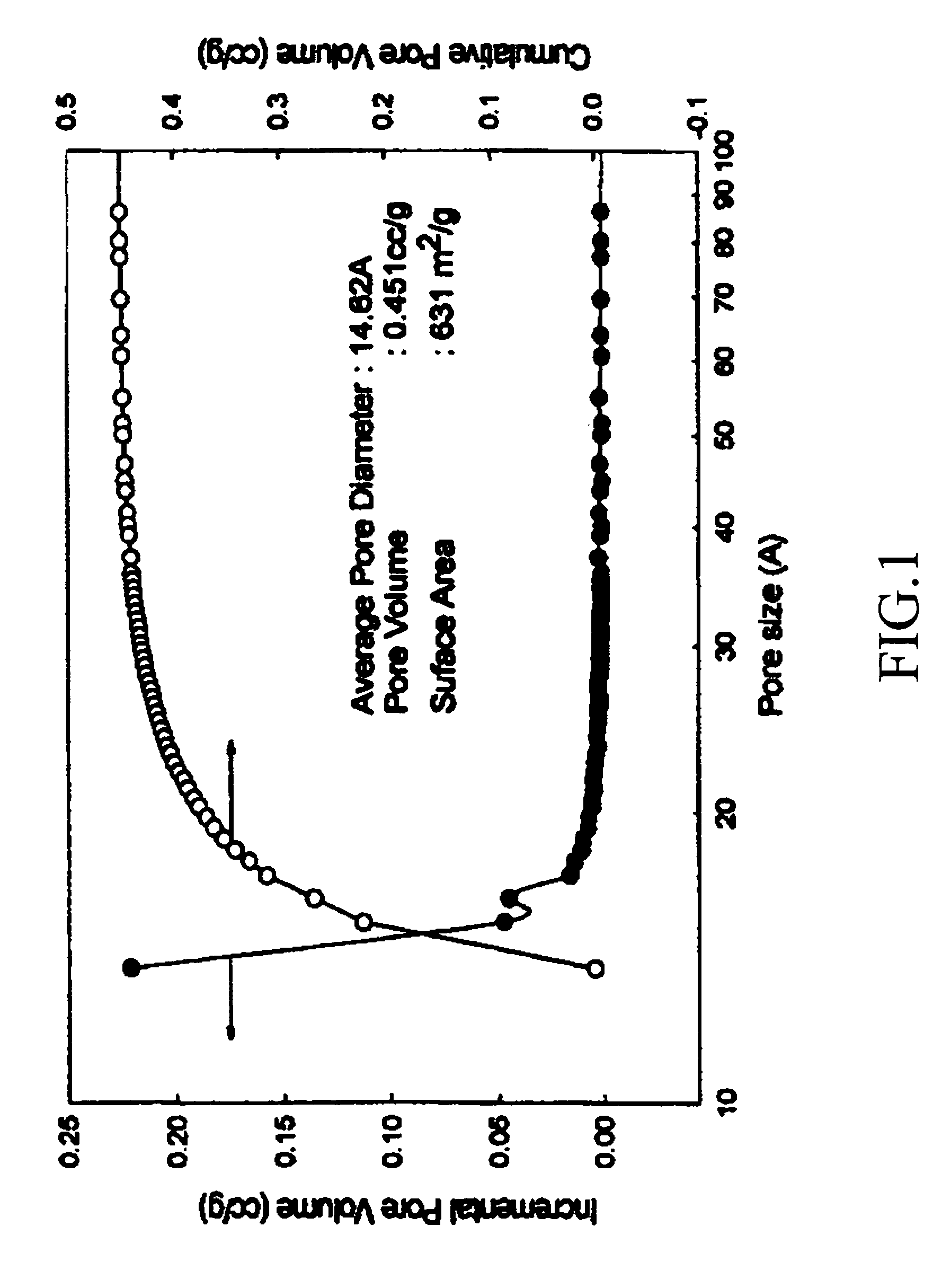Composition for preparing porous dielectric thin film containing saccharides porogen
a dielectric thin film and interlayer technology, applied in the field of composition for preparing porous interlayer dielectric thin film containing saccharides porogen, can solve the problems of non-uniform distribution of dielectric constants, insufficient dielectric constants of previous matrix materials,
- Summary
- Abstract
- Description
- Claims
- Application Information
AI Technical Summary
Problems solved by technology
Method used
Image
Examples
example 1
Synthesis of Matrix Monomers
EXAMPLE 1-1
Synthesis of Matrix Monomer A
[0063]To a flask were added 29.014 mmol (10.0 g) of 2,4,6,8-tetramethyl-2,4,6,8-tetravinylcyclotetrasiloxane and 0.164 g of platinum (O)-1,3-divinyl-1,1,3,3-tetramethyldisiloxane complex (solution in xylene), and then diluted with 300 ml diethylether. Next, the flask was cooled to −78° C., 127.66 mmol (17.29 g) trichlorosilane was slowly added thereto, and then the flask was slowly warmed to room temperature. The reaction was continued at room temperature for 20 hrs, and any volatile materials were removed from the reaction mixture under reduced pressure of about 0.1 torr. To the mixture was added 100 ml pentane and stirred for 1 hr, and then the mixture was filtered through celite to provide a clear colorless solution. The pentane was evaporated from the solution under reduced pressure of about 0.1 torr to afford a colorless liquid compound, [—Si (CH3)(CH2CH2SiCl3)O—]4 in a yield of 95%. 11.28 mmol (10.0 g) of the ...
example 2
Synthesis of Matrix Precursors
EXAMPLE 2-1
Precursor A: Homopolymerization of Monomer A
[0065]To a flask was added 9.85 mmol (8.218 g) monomer A, and then diluted with 90 ml tetrahydrofuran. Next, dil. HCl solution (1.18 mmol hydrochloride) prepared by mixing of 8.8 ml conc. HCl (35 wt. % hydrochloride) with 100 ml D.I.-water was slowly added thereto at −78° C., followed by addition of more D.I.-water, so that total amount of water including the inherent water in the above added dil. HCl solution might be 393.61 mmol (7.084 g). Thereafter, the flask was slowly warmed to 70° C., and allowed to react for 16 hrs. Then, the reaction mixture was transferred to a separatory funnel, 90 ml diethylether was added thereto, and then rinsed with 100 ml D.I.-water 5 times. Subsequently, 5 g anhydrous sodium sulfate was added thereto and stirred at room temperature for 10 hrs to remove a trace of water, and then filtered out to provide a clear colorless solution. Any volatile materials were evaporat...
example 2-2
Precursor B: Copolymerization of Monomer A and Methyltrimethoxysilane
[0066]To a flask were added 37.86 mmol (5.158 g) methyltrimethoxysilane and 3.79 mmol (3.162 g) monomer A, and then diluted with 100 ml tetrahydrofuran. Next, dil. HCl solution (0.0159 mmol hydrochloride) prepared by dilution of 0.12 ml conc. HCl (35 wt. % hydrochloride) with 100 ml D.I.-water was slowly added thereto at −78° C., followed by addition of more D.I.-water, so that total amount of water including the inherent water in the above added dil. HCl solution may be 529.67 mmol (9.534 g). Thereafter, the flask was slowly warmed to 70° C., and allowed to react for 16 hrs. Then, the reaction mixture was transferred to a separatory funnel, 100 ml diethylether was added thereto, and then rinsed with 100 ml D.I.-water five times. Subsequently, 5 g anhydrous sodium sulfate was added thereto and stirred at room temperature for 10 hrs to remove a trace of water, and then filtered out to provide a clear colorless solut...
PUM
| Property | Measurement | Unit |
|---|---|---|
| dielectric constant | aaaaa | aaaaa |
| dielectric constant | aaaaa | aaaaa |
| dielectric constant | aaaaa | aaaaa |
Abstract
Description
Claims
Application Information
 Login to View More
Login to View More - R&D
- Intellectual Property
- Life Sciences
- Materials
- Tech Scout
- Unparalleled Data Quality
- Higher Quality Content
- 60% Fewer Hallucinations
Browse by: Latest US Patents, China's latest patents, Technical Efficacy Thesaurus, Application Domain, Technology Topic, Popular Technical Reports.
© 2025 PatSnap. All rights reserved.Legal|Privacy policy|Modern Slavery Act Transparency Statement|Sitemap|About US| Contact US: help@patsnap.com



